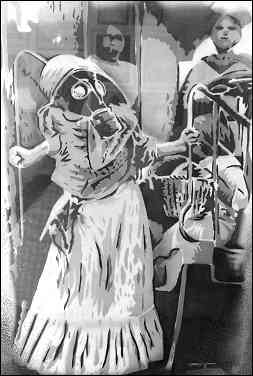During my live shows, I often do a song I wrote about the San Patricios, a band of mostly Irishmen who deserted from the U.S. Army during the Mexican-American war and fought on the Mexican side.
I start by doing a call-and-response with the audience. “Give me a ‘T’,” “give me an ‘R.,'” cheerleader-style, until we spell out, “Treason,” to introduce the story of the “Saint Patrick’s Battalion.”
It is a good laugh line since there are always some members of the audience who don’t realize what they are spelling out, and then shouting this very incendiary word. To commit treason is sometimes a moral choice people are faced with at critical junctures, and this was true of those men who deserted the ranks of the American army as it swept into Mexico during the U.S. invasion of 1846.

The art above is a détournement of a famous photo of an Adelita, revolutionary women who often bore arms. It is from the Espacio Zapata Arte Popular in Oaxaca, Mexico.
I first learned about this supreme act of solidarity, the forming of Mexico’s only foreign legion, during a lecture by the late historian, Howard Zinn, in Cambridge, Massachusetts sometime in the 1990s. I opened for him before his talk and wrote the song about the Battalion soon after.
I’ve never had a hit or anything close to it, but the way this story of solidarity has spread around the world through my song has been one of the great pleasures of my musical career. About once a day, I get a message commenting on the YouTube video of it in either English, Spanish, or some combination, saying something along the lines of, “Long live Ireland and the brotherhood of the Irish and Mexican peoples.”
The U.S. invasion of Mexico in 1846 was a naked imperial venture with the most bizarre possible fig leaf of legitimacy taking the form of a supposedly democratic state invading an undemocratic neighbor. The claims of democracy, however, ring very hollow when the invading state had a slave-based economy, and was invading a country, which although itself despotic, had abolished servitude.
The question of slavery was central to the invasion of Mexico, since the disputed land of Texas, whose constitution enshrined slavery, and the southern U.S. states were anxious to acquire increased territory in which it was permitted.
The U.S. slave economy was run primarily by Protestants, and Catholic immigrants were among the many people not warmly received by much of American society. For these and many other reasons, it should not be surprising that thousands of U.S. troops deserted from the ranks of the military as the U.S. Army fought, raped, and pillaged its way deeper into Mexico.
However, it was hundreds of soldiers of overwhelmingly Catholic backgrounds who were so repelled by the American atrocities they witnessed that they not only deserted from their military ranks, but joined the Mexican army. Among them were people from many countries including Poland, England, Canada, and the US, but Irish Catholics were the vast majority They became known as the St Patrick Battalion, or the San Patricios.
Most of them were killed in battle over the course of five engagements with the U.S. forces, the last being in August 1847 around the Mexican town of Churobusco, “overwhelmed by the cannons from Boston,” as the lyrics of my song go. Other battalion members were captured and publicly hanged, while their comrades were forced to help conduct the proceedings at the gallows.
Those who escaped capture after the last battle made their way deeper into Mexico and spent the rest of their lives as Mexicans, living in a town called San Jalisco, now a neighborhood in one of the world’s great, ancient metropolitan centers, Mexico City. It is said to this day that they are the cause of the red-haired children born in the neighborhood.
This story needs to be framed by the context of 1846 when all of Europe was undergoing crop failures, with a resulting massive spike in emigration to the U.S. from across the continent. Nowhere was the impact of the crop failures worse than in Ireland.
This was for entirely political reasons. In other parts of Europe there were alternatives to blighted potatoes available, if you could afford to pay for them. But in Ireland, because of British colonialism, those other crops were exported, and the Irish people were left to starve.
The Irish referred to their condition as slavery, and to one another as fellow slaves. While their conditions of enslavement differed from the huge plantations of the American South, the situation of the Irish people was one of landlessness in a land of plenty, where any efforts at survival such as fishing in the rivers could be met with the death penalty by their colonial British masters. Upon arriving in the U.S., often impressed into the American army, these refugees, mostly speaking only Irish, were sent to Mexico where they decided they could not participate in an unjust war.
As a songwriter and performer, I’ve learned that it is stories such as this that are deeply meaningful to audiences. The story of people risking their lives in a struggle for persons other than themselves is what defines human solidarity.
David Rovics is a Portland, Oregon-based singer/songwriter and anarchist. His weekly podcast, This Week with David Rovics, is available on all the usual platforms. His web site, DavidRovics.com, contains hundreds of his songs, including “Saint Patrick’s Battalion,” and his touring schedule.
